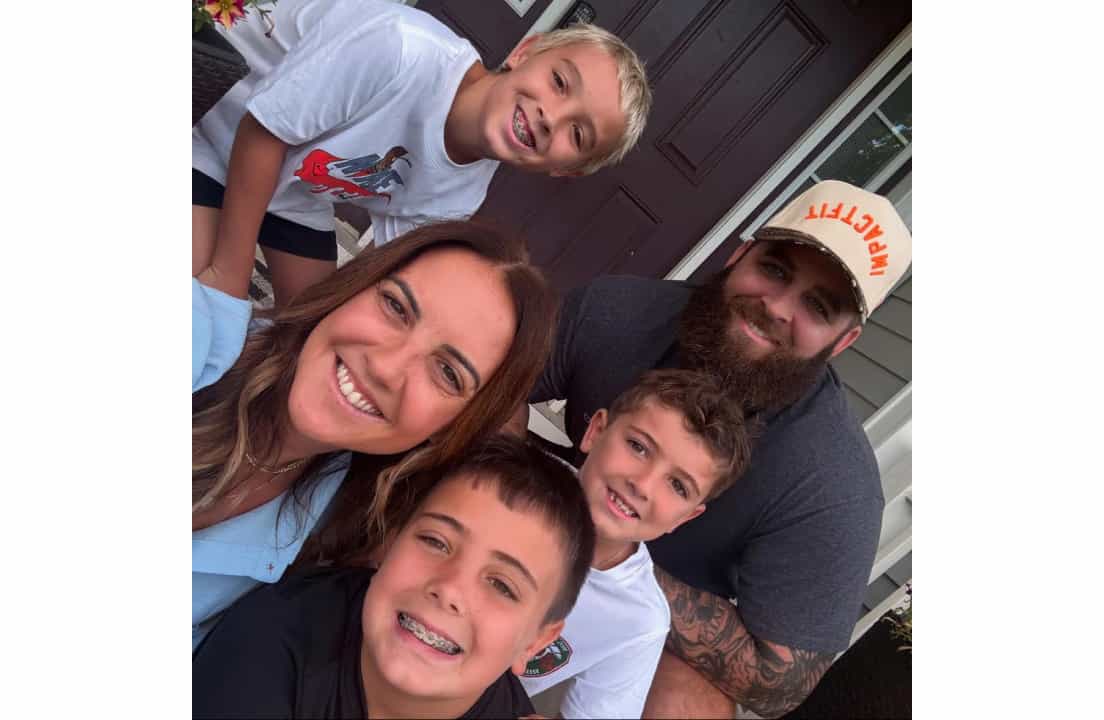T1D Guide
T1D Strong News
Personal Stories
Resources
T1D Misdiagnosis
T1D Early Detection
Research/Clinical Trials
Misdiagnosed, Determined, and Moving Forward: Matthew’s Story
When Matthew Rehrig opened his gym in 2015, he was in his mid-twenties and living his dream. He coached every session, handled sales, cleaned the floors, and kept the lights on—literally and figuratively. He was newly married, a new dad, and driven by a purpose to help people get healthier and stronger.
.jpg)
But behind that passion, something else was brewing.
The Slow Unraveling
Looking back, Matthew says the early symptoms of type 1 diabetes (T1D) were there. He just didn’t see them for what they were.
“As a mid-twenties guy, I thought I was invincible,” he said. “Men don’t go to the doctor. We figure we can handle it.”
He was losing weight, constantly tired, and drinking water by the gallon. He brushed it all off as a result of stress. “I knew I didn’t feel great, but I was working 15-hour days, stressed about money, and running a brand-new gym. I thought that was why I felt so run down.”
His wife, Ashley, noticed the changes before he did. “She said I didn’t just look skinny, I looked sick.” Even clients at his gym, some of them nurses, told him he didn’t look right. Eventually, at Ashley’s urging, Matthew went to the doctor for a physical.
The blood work showed a fasting glucose level of 211 mg/dL. It wasn’t high enough to cause alarm bells to ring for the provider, but it should have. Matthew was told to “watch his sugar” and was given a prescription for Metformin, a medication used for type 2 diabetes (T2D).
“They said it might be prediabetes,” he recalled. “They told me to exercise and eat more vegetables. I remember thinking, that’s literally my entire life.”
He followed the advice anyway. Months passed. Nothing improved. His energy was still gone, and his blood sugar levels remained high. When his A1c came back around 12, doctors finally realized what was happening: it wasn’t type 2. It was type 1.
The Dangers of a Missed T1D Diagnosis
By the time Matthew got the correct diagnosis, his body had been in chaos for months. He describes that time as foggy, physically and mentally. “Honestly, I don’t remember much from that period. It’s like my brain wasn’t working right.”
What he does remember are moments that scared his family. “One night, Ashley found me in the shower with all the towels soaked and water running cold. I’d been in and out all night, and I had no idea. Another night, she woke up, and I was standing in the corner of the room talking gibberish. She thought I was losing it.”
At one point, Matthew blacked out while driving to work. “I woke up an hour later going the wrong direction on the highway. I could’ve killed someone and not known.”
Those events finally pushed him back to the hospital. After brain scans and more tests, the answer came back—type 1 diabetes.
His body had stopped producing insulin.
“It runs in the family now.”

Just months before Matthew’s diagnosis, his younger sister had been diagnosed with type 1 at age 16. “It was the first autoimmune disease in our family,” he said. “No one could believe it when it happened again.”
Her diagnosis was more straightforward: classic symptoms, quick testing, clear treatment. Matthew’s, by contrast, was drawn out and confusing. “I don’t think I was angry,” he said. “It was just chaos: life, business, marriage, the gym. It was all happening at once.”
That combination of stress and immune dysfunction made him wonder about the connection. “I joked with Ginger (T1D Strong writer, Ginger Vieira) that I opened a gym to make people healthier, and the stress of it gave me diabetes,” he said, laughing. “Obviously, that’s not how it works. But part of me still wonders if that environment—the pressure, the constant stress—was the trigger.”
Still, Matthew’s not alone in thinking that way. Research indicates that individuals can test positive for type 1 antibodies years before symptoms appear. For some, it takes a major stressor or illness to activate the immune response. “If I hadn’t gone through that period of extreme stress,” he said, “I sometimes wonder if it ever would’ve been triggered.”
From Chaos to Finding a New Calm
Matthew’s approach to diabetes was pragmatic from the start. There was no denial phase, no “why me” moment. “I was already living a pretty disciplined life,” he said. “I ate clean, I worked out, I took care of myself. So I just kept doing that. I added blood sugar checks to my list and moved on.”
That mindset helped him manage both his business and his health. “My sister was 16—she had to grow up overnight. For me, it was just another thing to figure out.”
He noticed early on that diabetes management closely mirrored fitness training. “The way you teach someone with diabetes to manage blood sugar is almost identical to how you teach anyone to manage insulin spikes and body fat,” he explained. “Eat protein, eat produce, stay consistent. It’s the same foundation.”
Diabetes Tech Frustration and Finding Balance
For years, Matthew managed diabetes manually. “I liked the control,” he said. “My numbers were solid, my A1c was in range, so I didn’t feel like I needed tech.” His endocrinologist kept recommending an insulin pump. “I finally gave in and got the Dexcom and Omnipod about two years ago.”
The transition came with mixed feelings. “It does make life easier sometimes,” he said. “But it’s not perfect. When the cannula doesn’t insert right or the pod leaks, I waste insulin. Then I’m sitting at 250 (mg/dL) with no idea why. I’ll get so mad—like, what did I even do wrong?”
Still, he recognizes the value. “It helps prevent lows, which is huge. But some days, I miss doing it manually. There’s something about knowing exactly what’s going on without depending on a device that sometimes fails.”
Recently, he changed endocrinologists after his old clinic closed without notice. “The new doctor actually remembered me from when I was first diagnosed,” he said. “Turns out, that office I was going to was a disaster behind the scenes. It explains a lot.”
Coaching Through Lived Experience
Matthew’s gym isn’t branded for people with diabetes. Most of his members don’t live with chronic illness. But his experience informs how he coaches.
“When people come to me, they usually want fast results,” he said. “They want the body but not the process. Fitness doesn’t work like that. It’s slow, it’s frustrating, and it requires consistency.”

For people with T1D, he adds, the rules are different. “What works for someone else might not work for you. Your blood sugar levels change everything: energy, recovery, and performance. That’s why it’s important to find a community and coaches who understand.”
His advice for people with T1D who feel intimidated by strength training? “Start by getting clear on your goals,” he said. “Find people who are doing it well. Don’t reinvent the wheel. Follow the people getting results.”
And one message he stresses to every client, whether they have diabetes or not: build muscle. “We live in a catabolic state,” he said. “Our bodies are literally trying to break down muscle. Resistance training isn’t optional; it’s essential. Even if your goal is to lose weight, muscle is what keeps you healthy long term.”
What Matthew’s Learned Since Diagnosis
Looking back, Matthew doesn’t dwell on the “what ifs.” He wonders sometimes if a different lifestyle could’ve delayed his diagnosis, but he’s accepted that it’s part of his story now.
“The truth is, I don’t remember everything from that year,” he said. “But I do remember this: I didn’t quit. I just kept going.”
That resilience—the same drive that got him through misdiagnosis, business ownership, and fatherhood—still defines him today.
He continues to coach clients, many of them living with T1D, showing them that fitness isn’t about perfection or numbers on a scale. It’s about showing up for yourself every day, even when things don’t go to plan.
“It’s not about being the strongest in the room,” he said. “It’s about building strength in the middle of the chaos.”








.webp)

.jpeg)
.jpg)


.webp)
.jpg)
.jpg)




.jpg)

.jpg)
.jpg)


.jpg)

.jpg)
.jpg)
.jpg)
.jpg)
.jpg)

.jpg)
.jpg)
.jpg)
.jpg)
.jpg)
.jpg)
.jpg)
.jpg)
.jpg)
.jpg)

.jpg)
.jpg)
.jpg)

.jpg)
.jpg)


.jpg)
.jpg)
.jpg)
.jpg)
.jpg)














.jpg)


.jpg)













.webp)





%20(1).png)




.jpeg)






.jpg)













.webp)